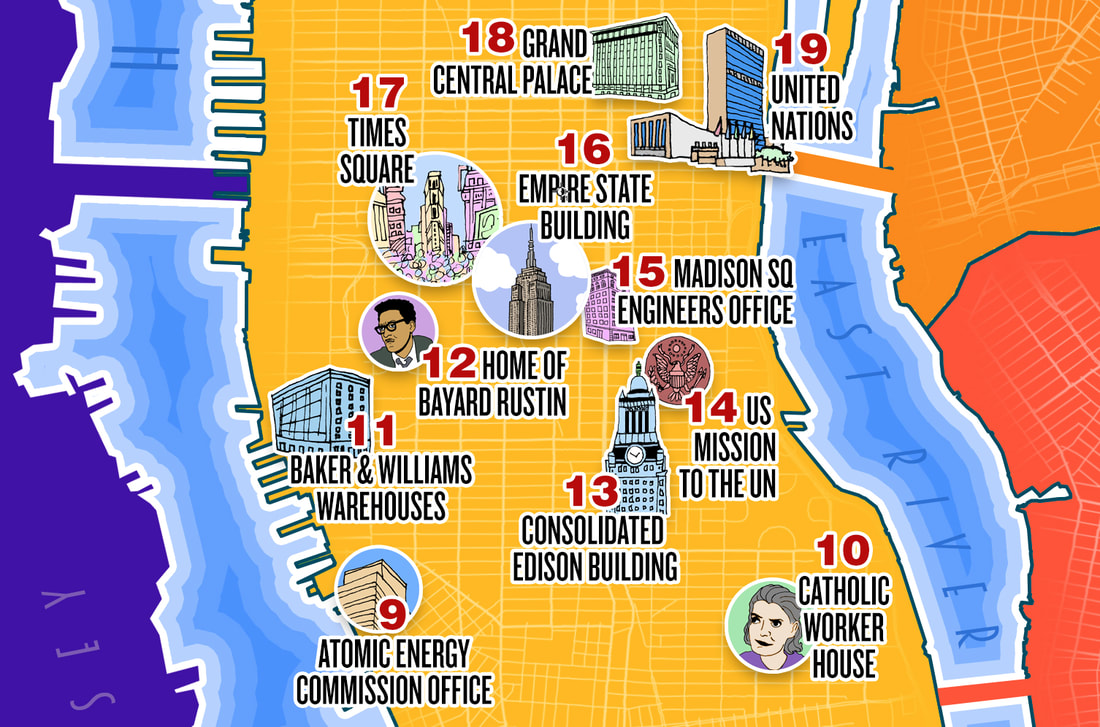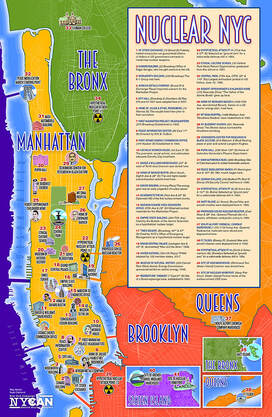Downtown Manhattan | Midtown Manhattan | Uptown Manhattan | Upper Manhattan & The Bronx | Brooklyn, Queens & Staten Island
|
The first office of the ATOMIC ENERGY COMMISSION (9) was established at 376 Hudson Street in 1946.
The CATHOLIC WORKER HOUSE (10) (55 East 3rd Street) is associated with the legacy of Brooklyn-born Dorothy Day, founder of the Catholic Worker movement. Day’s social justice advocacy included a strong commitment to the cause of nuclear disarmament. The Catholic Worker continues to feed and house poverty-stricken New Yorkers, whose numbers are on the rise. Three hundred thousand pounds of uranium were stored at the BAKER AND WILLIAMS WAREHOUSES (11) on West 20th Street, west of Tenth Avenue. Another antinuclear hero, BAYARD RUSTIN (12), first came to New York in the 1930s. His long career of activism included an arduous attempt to disrupt French nuclear testing in Algeria in 1959. In Ghana, Rustin was part of the Sahara Protest Team, whose antinuclear efforts were supported by tens of thousands of Ghanaians, and were credited with bringing the philosophy of nonviolent civil resistance to Africa. Rustin’s last years were spent in Chelsea (Penn South, Eighth Avenue & 28th Street), where his partner Walter Naegle still resides. Consolidated Edison, among the largest energy companies in the US, is headquartered in the CONSOLIDATED EDISON BUILDING (13) (4 Irving Place). ConEd operated the Indian Point nuclear power plant for over 25 years; ownership passed to Entergy in 2001. Until the plant was shut down in 2021, highly radioactive spent fuel coolant leached into the groundwater and the Hudson River. Spent fuel remains on at the site, characterized by Gordon Thompson as “pre-deployed radiological weapons, to be activated by an enemy.” The UNITED STATES MISSION TO THE UNITED NATIONS (14) is located at Park Avenue and East 33rd Street. The US remains the only nation to use nuclear weapons in war, when on August 6 and 9, 1945, the cities of Hiroshima and Nagasaki were obliterated by bombs produced through the Manhattan Project, killing hundreds of thousands. Due to radioactive contamination, nuclear weapons also poison the land and water for generations to come; survivors of Hiroshima and Nagasaki are still dying today, due to the latent effects of radioactive violence. Uranium and other materials were procured for the Manhattan Project by the MADISON SQUARE AREA ENGINEERS OFFICE (15) (Fifth Avenue & 29th Street). According to The Bulletin of the Atomic Scientists, if an 800-kiloton nuclear bomb exploded above the EMPIRE STATE BUILDING (16) (350 Fifth Avenue), “about one half to three quarters of a mile from ground zero, light from the fireball would melt asphalt in the streets, burn paint off walls, and melt metal surfaces within a half second of the detonation. Roughly one second later, the blast wave and 750-mile-per-hour winds would arrive, flattening buildings and tossing burning cars into the air like leaves in a windstorm.” In 2014, NYC’s Office of Emergency Management conducted an exercise to practice the city’s response to a hypothetical 10-kiloton bomb detonated over TIMES SQUARE (17) (Broadway, 42nd & 47th Streets). In the scenario, the team predicted the instantaneous death of more than 100,000 people, a shock wave destroying all buildings in a half-mile radius, an electromagnetic pulse knocking out communications, and fallout blanketing the region. In the summer of 1948, the exhibition hall GRAND CENTRAL PALACE (18) (Lexington Avenue & 43rd Street) hosted the “Man and the Atom” exhibit, intended to make the atomic bomb less frightening, and to promote peacetime uses of atomic power. The Beaux-Arts structure was demolished in 1964. For more than seven decades, the NYC home of the UNITED NATIONS (19) (760 United Nations Plaza) has been the site of innumerable deliberations about nuclear weapons. The first-ever UN General Assembly resolution was to “make specific proposals . . . for the elimination from national armaments of atomic weapons and of all other major weapons adaptable to mass destruction.” Seventy-two years later, in 2017, the Treaty on the Prohibition of Nuclear Weapons (TPNW) was adopted by 122 member states. The TPNW is the first-ever global ban on nuclear weapons, providing a framework for their verifiable elimination, and mandating assistance to communities affected by nuclear weapons use and testing. As Hiroshima survivor Setsuko Thurlow said in her statement at the time, “If you love this planet, you will sign this treaty.” |
EXPLORE THE MAP
|
The Nuclear NYC Map was created by Kathleen Sullivan, Noah Diamond, Seth Shelden, and Matthew Bolton for NYCAN, incorporating research by Catherine Falzone. Map design by Noah Diamond.
© 2022 NYCAN. All rights reserved. |




